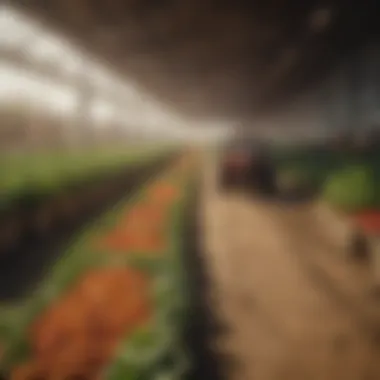Positive Effects of Climate Change on Agriculture


Intro
Climate change is often discussed in the context of its negative impacts on the environment and agriculture. However, it is critical to explore the multifaceted advantages it can bring within agricultural realms. These positive effects, while not universally applicable, can provide substantial opportunities for farmers and agricultural professionals. The increased temperatures and varying weather patterns may mean longer growing seasons and enhanced crop resilience, among other benefits. Understanding these changes can help farmers adapt their strategies to not just survive but thrive amidst the shifting climate.
Overview of the Topic
Definition and Importance
Climate change refers to significant, long-term changes in global temperatures and weather patterns. It is important to recognize that its impact on agriculture can be both negative and positive. For farming communities, adapting to these changes is essential. Embracing the potential upsides of climate change may result in better resource management and improved crop yields.
Current Trends
Recent trends indicate that some regions, especially those that previously faced limiting climates, are now experiencing better conditions for agriculture. For instance, areas that were once too cold for certain crops may now support cultivation. Innovations in agricultural practices are also gaining traction, as science and technology help in optimizing outputs.
"It's essential to embrace a dual perspective—as climate change poses challenges, it also unlocks new possibilities for sustainable farming."
Key Techniques and Practices
Step-by-Step Guide
- Analyze shifting climatic zones: Determine what crops may thrive in new climate conditions.
- Adapt planting schedules: Use extended growing seasons to increase productivity by planting crops earlier or harvesting later.
- Invest in research: Stay informed about studies on genetic crop modification and resilience strategies.
- Optimize soil management: Employ practices that enhance soil health to maximize yields, such as cover cropping and crop rotation.
Tools and Equipment Needed
Farmers can benefit from modern tools and technologies that align with changing climates. Some of these include:
- Drones for precision farming
- Soil sensors to monitor moisture levels
- Advanced irrigation systems to conserve water
- Specialized seed varieties that withstand increased temperatures
- Data analytics platforms to assess weather patterns and crop performance
Challenges and Solutions
Common Obstacles
Despite the positive effects, there are various challenges posed by climate change. These may include:
- Increased pest activity due to warmer temperatures.
- Unpredictable weather patterns affecting crop stability.
- Soil degradation from inconsistent rainfall and temperature shifts.
Innovative Solutions
To overcome these challenges, farmers can consider:
- Integrated pest management strategies that balance ecosystem health with crop protection.
- Implementing drought-resistant crops to mitigate water scarcity challenges.
- Adopting agroecological practices that restore soil health and enhance biodiversity.
Navigating the landscape of agriculture in a changing climate requires resilience, innovation, and a proactive approach. By understanding how to leverage the positive aspects of climate change, farmers can foster more sustainable agricultural practices and secure their livelihoods.
Intro
The topic of climate change often invokes strong reactions, primarily focused on its detrimental effects. However, this discussion neglects to address the potential positives it can bring to agriculture. This article explores the multifaceted ways in which climate change can enhance agricultural practices, productivity, and sustainability. By analyzing various aspects, it becomes clear that adaptation to changing environmental conditions can indeed offer several opportunities for farmers and agricultural stakeholders.
Understanding the positive effects of climate change is important for several reasons. First, recognizing these benefits can encourage farmers to innovate and adapt their strategies, ensuring long-term resilience and productivity. Second, as the world grapples with climate issues, the agricultural sector must take proactive measures rather than solely focusing on the challenges. Lastly, by approaching climate variability as an opportunity, agricultural professionals can enhance food security and economic viability.
"Every challenge can be viewed as an opportunity for growth, especially in the field of agriculture."
In the coming sections, we will delve into specific elements, including shifts in growing seasons, altered crop viability, soil health advances, and economic opportunities. Each of these areas provides insight into how climate change can contribute to a more resilient and productive agricultural landscape.
Understanding Climate Change
Climate change refers to long-term alterations in temperature, precipitation, and other atmospheric conditions on Earth. This phenomenon results from natural processes and human activities alike. The primary factor spurring recent changes is the increase in greenhouse gases in the atmosphere, mainly due to fossil fuel consumption, deforestation, and industrial processes.
Understanding these dynamics is critical for grasping how they impact agriculture. Changes in temperature can extend or shorten growing seasons, while shifts in precipitation can either benefit crop yields or lead to adverse effects like drought. Recognizing these variables helps in developing strategies to leverage positive effects while mitigating negatives.
The implications of climate change on farming practices are profound. Farmers must adapt to evolving weather patterns and choose crops or techniques that can thrive under new conditions. This adaptability is not just about survival; it also opens doors for increased agricultural productivity and enhanced soil health.
Shifts in Growing Seasons
The topic of shifts in growing seasons is critical when evaluating the impacts of climate change on agriculture. As the climate changes, traditional growing periods are altered, presenting both challenges and opportunities for farmers. Understanding these shifts can lead to improved agricultural practices and increased productivity.
Extended Growing Periods
One significant aspect of shifts in growing seasons is the extension of the growing periods. Warmer temperatures in many regions allow crops to be planted earlier in spring and harvested later in fall. This not only maximizes the yield per acre but also enables farmers to consider double-cropping, which involves growing two different crops in the same year on the same land.


- Benefits of Extended Growing Periods:
- Increased crop yields due to more favorable growing conditions.
- Opportunities for farmers to diversify their crops and explore new varieties that were previously unsuitable for their region.
- Potential for higher profitability through multiple harvests in a single year.
This extension may vary across different climatic regions. Some areas may see a significant increase in the number of frost-free days, which can be a game changer for many farmers. However, it is essential to note that not all regions will experience these positive shifts uniformly. Understanding local climate projections is vital to making informed decisions.
Impact on Crop Selection
The changing climate influences the types of crops that can be grown effectively. As temperatures rise, farmers can consider new varieties that may have better resilience or productivity in warmer conditions. This prompts many to revisit crop selection strategies.
- Considerations for Crop Selection:
- Examination of historical data to determine which crops thrived in warmer periods in the past.
- Exploration of genetically modified varieties that are designed to withstand higher temperatures or drought conditions.
- Strategies to incorporate crops that have a shorter growth cycle, thus aligning with the extended growing seasons.
Adapting crop selection also requires education and research. Farmers must stay informed about the latest agricultural trends, and they may benefit from the support of agricultural extension services. This proactive approach can lead to resilience against climatic changes and ensure sustainable farming practices moving forward.
Altered Crop Viability
The evolving climate landscape brings significant changes to agricultural practices, particularly in the realm of crop viability. It is essential to recognize that some crops may flourish in conditions that were previously unsuitable. This phenomenon not only influences what is cultivated but also impacts food security, economic potential, and ecological balance. As climate change continues to progress, farmers and agronomists must adapt to these changes by embracing the opportunities presented by altered crop viability.
Emergence of New Crops
The rise in temperatures coupled with changes in precipitation allows for the introduction of new crops in various regions. For instance, some heat-tolerant varieties are beginning to replace traditional crops that may struggle under increasing temperatures. This trend is crucial as it can lead to improved yields and diversification of agricultural production. Furthermore, some crops that were once limited to tropical climates are now becoming viable in subtropical and even temperate regions. Adaptation is key for farmers in these areas. They need to explore new options that might not only survive but also thrive despite altering conditions.
- Heat-tolerant varieties: Crops like millet and sorghum are gaining popularity.
- Diverse options: This allows farmers to mix and match depending on local conditions.
These developments can ultimately lead to a more resilient agricultural sector that can cope with climatic unpredictability.
Regions Becoming More Arable
Another pivotal element is the transformation of previously inhospitable regions into arable land. As areas warm up, previously unfavoured lands may present new prospects for agriculture. Places that were too cold and dry to cultivate crops are becoming more conducive to farming. For example, parts of northern Canada and Russia are experiencing a shift towards agriculture, offering new economic potential.
- Ideal climates: The warming climate enables longer growing seasons and milder winters.
- Increased arable land: Regions that were unsuitable for planting are now reconsidered.
Farmers located in these regions can benefit from this shift. They can enhance food production, which could contribute to local economies.
In summary, altered crop viability due to climate change provides both challenges and opportunities. By focusing on new crops and expanding arable regions, agriculture can adapt positively, ensuring continued productivity amid change.
Soil Health Advances
Soil health is fundamental to agriculture. It ensures that plants have access to the nutrients, water, and structure they need to grow. Advancements in soil health due to climate change can lead to significant benefits for farmers and enhance agricultural productivity. This section explores how climate change positively influences soil health.
Changes in Soil Microbiology
Climate change alters the temperature and moisture levels in the soil, which can lead to changes in soil microbiology. Soil microorganisms, including bacteria, fungi, and protozoa, are crucial for nutrient cycling, organic matter decomposition, and plant health. Warmer temperatures may enhance microbial activity in certain regions, accelerating the breakdown of organic materials.
As a result, nutrients become more available to plants. These changes can improve crop yields and soil fertility. However, farmers must pay attention to these shifts, as different microbial populations can affect soil structure and function. Understanding these dynamics is key in tailoring soil management practices to maintain a balance in soil health and productivity.
Carbon Sequestration Opportunities
Another important aspect is carbon sequestration. Healthy soils can store carbon, which helps mitigate the effects of climate change. As temperatures rise, the capacity of soils to sequester carbon may increase in some regions. Agricultural practices such as cover cropping, reduced tillage, and organic amendments can enhance this process.
When soils are well-managed, they can absorb more carbon from the atmosphere, transforming it into organic matter. This not only helps to improve soil structure and nutrient availability but also plays a role in reducing greenhouse gases. To leverage this opportunity, farmers should consider integrating sustainable practices into their farming systems.
"Healthy soils are vital for food production and can act as a carbon sink, benefiting both agriculture and the environment."
Economic Opportunities
The topic of economic opportunities in agriculture due to climate change serves as a crucial element in understanding the broader implications of this global issue. Many experts often focus solely on the adverse effects of climate change; however, examining the positive consequences can provide a roadmap for farmers and agribusinesses to adapt effectively. Recognizing economic opportunities can lead to innovation and growth within the agricultural sector, enabling it to navigate the current and future challenges a warming planet presents. This section dives into how the shifts caused by climate change can create new markets and investment potentials.
Market for New Crops
As climate change progresses, regions that were previously unsuitable for certain crops may now become viable for cultivation. This opens a unique market for new crops that were once deemed impractical. For instance, crops like quinoa or certain varieties of millet, previously grown in more temperate climates, can find a niche in areas that are warming.
Farmers should consider the following:
- Diversification: Growing a wider variety of crops can mitigate risks associated with climate change, such as unpredictable weather patterns or pest infestations.
- Consumer Interest: There is a growing market trend towards organic and exotic crops. Consumers increasingly value diversity in their diets, which can boost sales for farmers willing to innovate.
- Financial Support: Governments may offer grants or subsidies for farmers who try out new crops, reducing upfront costs and encouraging experimentation.
Highlighting the potential for new crop markets can attract attention from both local and international buyers. Farmers can tap into these emerging markets, which can enhance their profitability and sustainability as they adapt to changing environmental conditions.


"The most successful farmers will be those who can adapt to the changing landscape and seize opportunities created by climate shifts."
Investment in Sustainable Practices
Investment in sustainable practices is another critical area where climate change could positively influence agriculture. As the agricultural sector evolves under the pressures of climate change, there is a pronounced shift toward sustainability as both a practice and a principle. This change transcends simply growing crops in environmentally friendly ways; it encompasses a holistic approach to farming that balances economic needs with ecological stability.
The following investments are becoming increasingly relevant:
- Technological Development: Farmers can invest in modern technologies that promote sustainable practices, such as precision agriculture tools. These tools use data to enhance farming efficiency, decrease waste, and optimize resource use.
- Water Conservation Methods: Implementing rainwater harvesting and drip irrigation systems can significantly reduce water usage. This investment is particularly important in areas experiencing shifts towards drier climates.
- Soil Health Practices: Techniques such as cover cropping and reduced tillage can help retain moisture and improve soil fertility. Investing in these practices can lead to greater crop yields in the long term.
The shift towards sustainability not only meets the increasing consumer demand for environmentally friendly products but can also lead to reduced operational costs in the long run. Embracing sustainable practices can create a competitive advantage in the market as consumers and policymakers increasingly prefer sustainable options.
Innovations in Agricultural Practices
Innovations in agricultural practices represent a pivotal shift in how farming adapts to the changing climate. As climate conditions evolve, so does the need for methods that not only preserve resources but also enhance productivity. These innovations are crucial for addressing challenges posed by climate change while maximizing the benefits it may bring to agriculture.
Advancements in Technology
Technological advancements play a significant role in reshaping the agricultural landscape. Innovations such as drones, artificial intelligence, and automation bring forth substantial improvements. Farmers can now monitor crop health and soil conditions more effectively. For instance, drone technology allows for real-time imaging that provides insights into crop stress levels or pest infestations. This aids in targeted interventions, reducing waste of resources like water and pesticides.
Moreover, data analytics is transforming decision-making processes. With the integration of predictive analytics and machine learning, farmers can forecast yields with greater accuracy. Such foresight enables better management of resources and optimizes production schedules, ultimately leading to increased profitability.
Adoption of Precision Agriculture
Precision agriculture involves the use of data-driven insights to make informed decisions about crop management. This method focuses on adjusting inputs like water, fertilizers, and pesticides based on the specific needs of crops in various areas of a field. By applying resources more accurately, farmers significantly reduce costs and environmental impact.
For example, soil sensors can provide real-time data about moisture levels and nutrient content, allowing farmers to apply only what is necessary. This not only enhances productivity but also addresses sustainability concerns.
In addition, GPS technology helps in accurate field mapping and tracking equipment, leading to better operational efficiency. As a result, farmers are not just reacting to environmental changes but proactively managing their crops for their best performance.
In summary, innovations in agricultural practices, driven by technology and precision methods, present an opportunity for farmers to harness the potential of climate change productively. These trends not only mitigate adverse effects but also unlock new avenues for growth.
Ecological Adaptations
Ecological adaptations play a crucial role in understanding how climate change influences agricultural landscapes. This section highlights the various ways in which ecosystems are responding to the shifting climatic conditions brought about by global warming. These adaptations are not just reactions; they provide opportunities for agriculture to thrive amid changing conditions. Notably, ecological adaptations can improve resilience, allowing farms to respond positively to environmental stressors.
Restoration of Natural Habitats
Restoration of natural habitats becomes increasingly significant as agricultural areas face the pressures of climate change. Rehabilitating ecosystems can support biodiversity and enhance local microclimates. For instance, reintroducing native plant species can help stabilize soils and improve water retention. This directly benefits agricultural practices by reducing erosion and enhancing nutrient cycles.
Furthermore, natural habitats act as buffers. They can absorb excess rainfall or help mitigate the impact of drought, which is becoming more common due to climate variability. Farmers who engage in habitat restoration can benefit from the additional ecosystem services such as pollination and pest control.
"Restoring natural habitats is not just an environmental effort; it’s a smart agricultural strategy that can lead to better crop yields and healthier ecosystems."
Biodiversity Enhancement
Enhancing biodiversity is essential in adapting agriculture to climate change. Diverse ecosystems are generally more resilient to disturbances. For farmers, this can translate to increased crop yields and reduced vulnerability to pest outbreaks. Crops grown in biodiverse environments often benefit from a range of species that support soil health and pest regulation.
In addition, biodiversity can play a critical role in ensuring food security. With climate change leading to uncertainties in production, having a variety of crops can act as a safeguard. Farmers can turn to crop diversity to mitigate risks associated with climate extremes, thereby ensuring steady food supply and income.
In essence, ecological adaptations not only foster resilience but also present an opportunity for farmers to innovate and maintain productivity amid changing conditions. The benefits of restoring natural habitats and enhancing biodiversity are clear; they are strategies that align agricultural practices with ecological integrity.
Resilience Against Climate Extremes
Resilience against climate extremes is a critical aspect of modern agriculture. Farmers increasingly face unpredictable weather patterns due to climate change. However, by developing adaptive strategies, they can mitigate some risks associated with these extremes. This section focuses on two significant supports for resilience: the creation of drought-resistant crops and flood adaptation strategies.
Development of Drought-resistant Varieties
Drought-resistant varieties are essential for addressing water scarcity challenges. Climate change often leads to prolonged dry spells, reducing water availability for crops. By investing in research, scientists are developing plant breeds that can thrive with less water. These varieties utilize physiological traits that allow them to maintain growth and yield under drought conditions.
Key benefits of adopting drought-resistant crops include:
- Reduced need for irrigation, lowering water usage.
- Increased crop yields even in adverse conditions.
- Financial savings for farmers due to lower operational costs.
Farmers who choose these modern varieties can navigate water stress more effectively. They can rest assured that they have resilient options in face of escalating drought risks. Furthermore, this builds a more sustainable agricultural system. This system can adapt as climate conditions evolve.
Flood Adaptation Strategies
Flood adaptation strategies are equally important. Climate change can lead to intense rainfall events, which risks damaging crops and eroding soil. Farmers must prepare for these scenarios to protect their harvests. There are several practices that support flood resilience in agriculture.


Some effective strategies include:
- Improved Drainage Systems: Creating better drainage helps prevent water accumulation. It reduces the risk of crop drowning.
- Raised Bed Cultivation: Elevating growing beds can safeguard root systems from excess water. This also supports better air circulation around plants.
- Planting Cover Crops: Cover crops can improve soil structure and reduce erosion. They can also enhance organic matter in soil, helping it retain more water during dry periods.
Adopting these strategies enables farmers to cope with flooding while maintaining productivity.
"By embracing innovative approaches to mitigate climate extremes, farmers can safeguard their livelihoods in an unpredictable environment."
Investing in both drought-resistant varieties and flood adaptation strategies is not just prudent but essential for future agricultural success. Farmers who actively seek to enhance resilience can better navigate the challenges posed by climate change, ensuring that their practices remain viable and sustainable.
Global Perspectives
Understanding the global landscape of agriculture under the influence of climate change is crucial. This section highlights how regions can leverage specific circumstances to enhance agricultural productivity. Recognizing that climate change influences different areas in distinct ways allows countries to identify and capitalize on their comparative advantages. Each region possesses unique resources and climatic conditions that shape its agricultural potential. By exploring these differences, stakeholders can make informed decisions that align with their local environments and market needs.
Comparative Advantages in Different Regions
Various regions around the world will experience climate change differently. For instance, certain areas may move toward warmer temperatures, which can extend the growing season for select crops. Countries in northern latitudes may find new opportunities as they become able to cultivate crops previously limited to warmer climates. This transition can facilitate crops such as soybeans, corn, and specific varieties of fruits that thrive under warmer conditions.
- Northern Europe may benefit through increased agricultural outputs due to a longer growing season.
- Tropical regions may see a shift, potentially reducing yields of their traditional crops but opening doors to others like cassava and moringa.
The ability to leverage these changes is a substantial advantage for nations pursuing agricultural expansion. Farmers must stay ahead of these shifts to adjust their practices according to evolving climatic contexts.
International Trade Opportunities
The evolving agricultural landscape may reshape global trade dynamics. As some countries achieve greater agricultural productivity due to beneficial climate effects, others may struggle. This divergence creates opportunities for international trade. Countries with surplus production can export products to those facing declines in yield.
Considering trade relations, specific emphasis falls on:
- Emerging markets for new crop varieties that thrive in changing conditions.
- Establishing trade agreements that favor agricultural resilience and sustainability.
- Diversifying crop offerings to meet global demand as suppliers adjust based on climate realities.
"Agricultural trade can provide a buffer against the adverse effects of climate change, supporting economies and food security on a global scale."
To capitalize on these opportunities, it is vital for policymakers to design trade frameworks that promote climate-resilient practices. This way, regions can not only adapt but also thrive amid a changing agricultural paradigm.
Regulatory and Policy Implications
Government Support for Climate-resilient Agriculture
Government backing is essential for promoting climate-resilient agriculture. Programs providing financial assistance, research funding, and technical support can help farmers transition to methods that can withstand climate variability. For example, subsidies for cover crops and no-till farming can enhance soil health and optimize water use.
Furthermore, local governments can offer training sessions for farmers, educating them on sustainable practices. Policies aiming to mitigate risks associated with climate change encourage farmers to adopt innovative techniques. Enhancing knowledge and resources for agricultural communities fosters resilience against climate-related disruptions.
- Financial Incentives: Governments can offer grants or low-interest loans for adopting sustainable practices.
- Research and Development: Supporting scientific research on climate-resilient crops can lead to improved seed varieties.
- Training Programs: Educating farmers on best practices increases the likelihood of implementing new technologies.
"Government support for climate-resilience not only aids farmers but also promotes food security and environmental health."
Trade Policies Favoring Innovative Practices
Trade policies are another crucial component. Regulations that favor environmentally-friendly practices can create market opportunities for farmers. By lowering tariffs on sustainably produced goods, governments encourage the adoption of innovative methods. Export incentives for climate-smart agricultural products can expand markets for farmers, benefiting their income streams.
Adaptations in trade policies can also stimulate international collaboration. Knowledge sharing between countries can lead to the exchange of best practices in climate resilience. This collaborative approach allows regions to learn from each other, paving the way for optimized agricultural techniques.
Ending
The positive shifts in growing seasons allow for the enhancement of crop yields. Extended periods of favorable weather enable farmers to experiment with diverse crops that may have been previously unsuitable. Additionally, changes in soil health and microbiology resulting from shifting climates are beneficial. Healthier soils can lead to better nutrient retention and improved productivity.
Recognizing these components helps mitigate the threats posed by climate change. Farmers can adapt their strategies to harness these beneficial changes, potentially leading to increased economic viability. This adaptive response can set a precedent for sustainable agricultural practices.
The findings imply that focusing solely on the challenges of climate change may overshadow these potential benefits.
The ability to adapt and innovate in response to climate change is crucial for the resilience of agriculture in the future.
Summary of Findings
The examination of various factors underscores the complexity of climate change's influence on agriculture. Several significant findings emerge:
- Extended Growing Seasons: Farmers can grow crops for longer periods, enhancing productivity.
- Emergence of New Crop Varieties: The changing climate can allow for the introduction of crops previously not viable in certain areas.
- Soil Health Improvements: Alterations in temperature and moisture can lead to a more vibrant soil ecosystem.
- Investment Opportunities: Economic benefits arise from the market for new crops and innovative agricultural technologies.
- Global Trade Considerations: Certain regions may gain comparative advantages through positive climate shifts.
Each of these points contributes to a broader understanding of how agriculture can adapt to and benefit from climate change.
Future Directions for Research
Looking forward, it is imperative to continue investigating the multifaceted relationship between climate change and agriculture. Some potential areas for future research include:
- Crop Resilience Studies: Research focused on developing crop varieties with greater tolerance to climate variability.
- Soil Microbiome Research: Understanding the dynamic changes in soil health as climates shift can yield new agricultural practices.
- Economic Analysis: Further exploration of market trends for newly viable crops can guide investment and policy decisions.
- Technological Advancements: Evaluating how emerging technologies can support sustainable practices amidst changing environmental conditions.
- Policy Frameworks: Investigations into effective policies that support resilient agricultural systems in the face of climate change challenges.
Continued research is essential for identifying adaptations that can take advantage of the opportunities presented by climate change. Such studies will be crucial for informing farmers and guiding policy decisions in agriculture.



